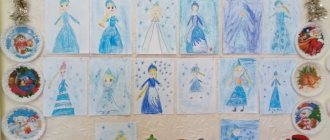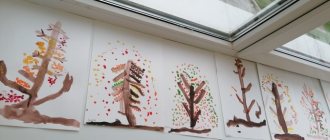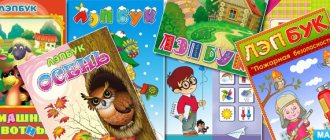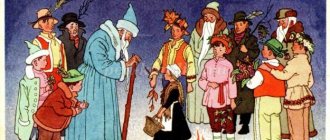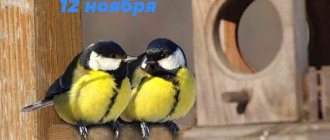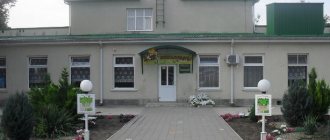Summary of an integrated lesson for children 6-7 years old on the topic: Seasons
Description of the material: The lesson is aimed at consolidating knowledge and ideas about the season, its features and signs. Specifics of the lesson: clarity, compactness, high information content of the educational material, due to which one of the basic principles of preschool didactics is implemented - the lesson should be small in volume, but capacious, which is possible with an integrative approach, when a specific subject or phenomenon is considered from several sides in different ways. aspects; a large number of different visual materials and attributes are used; switching to a variety of activities helps to keep children’s attention, which increases the effectiveness of the lesson, relieves fatigue and overstrain. The “main thread” of this integrated lesson is the music of the seasons – color – a person’s mood. The selected material and technical support made it possible to maintain the children’s interest throughout the entire activity. Program content: • Develop children's creativity in visual, musical, speech and theatrical activities; • Enrich the vocabulary with emotional and evaluative vocabulary; • To instill in children a sense of beauty, a love of nature and their native land. Preliminary work: listening to “Winter” by A. Vivaldi, the play “The Bells Are Ringing” by W. Mozart, the play “Waltz of Snow Flakes” from the ballet “The Nutcracker” by P. I. Tchaikovsky; viewing reproductions: “February Azure” by I.E. Grabar, “Winter” by I.I. Shishkin, “Vyuzhit. Blizzard" A.M. Vasnetsov; conversation on the topic “What is mood and does nature have it?”; artistic and educational game “Guess the mood”; reading poems about winter. Developmental environment: reproductions of paintings: “February Azure” by I.E. Grabar, “Winter” by I.I. Shishkin, “Blizzard” by K.A. Korovin; synthesizer, multimedia installation, music for relaxation (disc), music center, piano, children's musical instruments; glass with processed edges, white gouache, brushes, napkins, jars of water, an exhibition of children's drawings about winter. Methods and techniques: informative - receptive (examination, observation); verbal (conversation, story, artistic expression), heuristic, TSO, ICT. CONTENT
Children enter the hall to the music and stand near the chairs.
Teachers: Hello, guys! Let's greet each other with a song! Chant - greeting "Good afternoon" children sit down Teacher (draws attention to the exhibition of drawings about winter): Guys, look, today we have an exhibition of drawings in the music room. — What time of year is depicted on them? - Name the winter months (children's answers) - Do you like winter? Why? — Are all winter days alike? — What is the weather like in winter? Teacher: Poets, artists, composers convey the mood of winter in colors, poems, and music. Look at these pictures. They look at the paintings: 1) “February Blue” by I.E. Grabar 2) “Winter” by I.I. Shishkin 3) “It’s blowing.” Blizzard" A.M. Vasnetsov Conversation: What is depicted? Remember what it's called? What is the mood of the picture? Teacher: In the works of composers and poets, winter is also very different: with thaw, and with snowstorms, and snowy, and sunny. You and I know a song about winter. (They get up and sing the song “White Winter”, music and lyrics by L. Kuklina)) Musical director: Winter is perhaps the most magical time of the year. She gives us the most fun games, the most interesting fairy tales on long winter evenings. In one night, winter can create a completely new picture in nature. The poem “Winter Morning” by A.S. sounds. Pushkin against the backdrop of music and at the same time showing slides with winter landscapes. Musical director: Now listen to the music (“Winter” by A. Vivaldi, excerpt). Musical Director: Did you recognize her? Musical director: Correct. This musical work by composer A. Vivaldi is called “Winter”. Musical director: What natural phenomenon do you think the composer depicted? Let's get creative. Children assume that it is a blizzard, a blizzard, or a strong wind. Musical director: Indeed, it was as if a strong wind blew and a blizzard swirled. Teacher: It seems to me that there was even a whiff of cold... Yes, it was the Snow Queen herself who rushed by! Do you want to fly after her? Then imagine that we have invisible hats, we will put them on and close our eyes. Children pretend to put on invisible hats and close their eyes. Teacher (recites to the sound of the wind). The weather began to rustle, the weather cleared up in the field, and the smooth road was covered with white snow. Covered with white snow. not a trace to be seen. Dust and a blizzard rose, and there was no light left. Teacher: Open your eyes. And here we are at the Snow Queen. In her snowy kingdom it is very cold, everything is covered in ice. You and I can also turn into ice figures. Musical game “Ice Figures” (Children perform various movements to the music. At the end of the music, they “freeze.” The teacher must guess what kind of figure it is. At the end of the game, the children sit down). Teacher: Hush, hush! Do you hear? A chime can be heard from somewhere. The play “The Bells Are Ringing” by W.A. Mozart (synthesizer) Teacher: Who in the kingdom of the Snow Queen could have such a voice? Children describe the voice they hear: fabulous, light, crystal, magical, extraordinary, ringing, glassy, cold. Musical director: Maybe these snowflakes are the servants of the Snow Queen? They talk like this, touching each other with crystal rays. And now I invite you to play. Didactic game “What sounds” (Children are asked to choose from alternately sounding instruments the one that resembles the voice of crystal snowflakes (metallophone, triangle, bell, tambourine, xylophone, etc.) Teacher: Look at the snowflakes, how different they are: round, shaggy , with sharp rays, etc. (They look at the snowflakes on the screen)
But then amazing music flowed around, the snowflakes began to spin in a round dance. An excerpt from the ballet “The Nutcracker” by P.I. Tchaikovsky “Waltz of the Snow Flakes” is playing.
Teacher: We are with you Let's also try to dance like snowflakes. The children are spinning in the dance like snowflakes (improvisation}
Teacher.
Well done, you danced very beautifully, but it's time for us to return to kindergarten. Let's close our eyes and slowly take off our invisible hats. Children close their eyes and "remove" the invisibility hats. Teacher: Well, here we are again in the music room. And now I invite you to draw different, unusual in shape, light snowflakes on the glass. Children come up to the tables, while listening to the music they draw different snowflakes on the glass with gouache, Frost patterns. (Music for relaxation) After finishing the work, the children walk around and look at the drawings. Teacher: Well done! Guys, did you like our trip? What did you like most? We also really liked the way you sang, danced, and drew. Winter is truly a wonderful time of year, but it is coming to an end, and in a year it will again delight us with magical snow patterns, beautiful snowflakes and different songs of blizzards.
We recommend watching:
Summary of an integrated lesson in a preparatory group with general speech underdevelopment of the third level. Summary of an integrated lesson in a preparatory group. A rocket flies into space Integrated lesson in the preparatory group. Space travel Summary of an integrated lesson - exhibition in the preparatory group of a preschool educational institution
Similar articles:
Summary of an integrated lesson in the group of software “Alien from an unknown planet”
Lesson summary – travel on the topic “School” in the preparatory group
Summary of the lesson “Take care of nature” in the preparatory group
Summary of the lesson “Seasons” in the preparatory group
Lesson summary on the topic “Seasons” for older preschoolers
Progress of the lesson
The teacher and children enter the group.
They stand in a circle and perform an exercise aimed at improving their mood. All the children gathered in a circle: I am your friend and you are my friend.
Let's hold hands tightly and smile at each other. Educator: Children, look today we have guests. Let's say hello to them and give our good mood to the guests. The group includes a character (Lesovichok). Lesovichok: Hello children, do you recognize me? Children: Yes, you are Lesovichok. You protect the forest, animals, birds. Lesovichok: Today I came for your help. I live in a fairy forest. There was peace and harmony in nature. Suddenly something changed in him. All seasons have changed places. After winter came summer, after summer came spring, and only after spring came autumn. - But that doesn’t happen! And I can’t do it alone, help me guys put things in order in the fairytale forest. Our path will not be easy; we must remember all the seasons, their signs and characteristics. Educator: Guys, let’s help Lesovich clean up the fairytale forest? Children: Yes, of course we will help. Educator: Then we go to the fairy forest. Lesovichok: - And we will travel on an unusual fairy-tale transport - an airplane carpet. We'll take all our friends on the magic carpet. Let him carry us all across the blue sky Through mountains, seas, oceans. To a fairy forest and magical lands. Lesovichok: Snow on the fields, Ice on the rivers, Blizzard is walking, When does this happen? Children: In winter. (The teacher with the children and Lesovich approach the winter landscape). Educator: what can you say about winter? Children: - The whole earth, houses, trees were covered with snow. — It’s frosty outside, — The birds don’t sing happy songs, — The wind is prickly, cold, blizzard, snowfall. — The rivers are covered with ice. — People are dressed in warm clothes. — The days have become shorter and the nights longer. The sun rarely shines. Educator: Yes, it’s cold outside. Why do we love winter so much? Children: - In winter you can go sledding, skiing, skating. — Build a snowman, play snowballs, build a snow town. — In winter there is New Year, my favorite holiday. — Santa Claus brings gifts. In winter, my dad and I make bird feeders. Lesovichok: Snowflakes want to play with us, they want to know more about themselves, say “Which one is Snowflake?” Children: The snowflake is light, beautiful, spins, and lies on the ground. The snowflake is cold, as soon as you take it in your palms, it melts from the heat and turns into water. And in the cold, the water freezes and becomes ice. Lesovichok: Tell me guys, what happens: A slide made of snow is snowy (children’s answer)
A path made of ice is icy
(children’s answer)
Weather with frost is frosty
(children’s answer)
Weather with wind is windy
(children’s answer)
.
Lesovichok: What a fellow you are, you know everything about winter. Educator: Guys, do you hear the streams ringing, the rooks have arrived. The bee brought the first honey to her hive. Who can say, who knows, When this happens? Children: In the spring. (The teacher with the children and Lesovich approach the spring landscape). Lesovichok: I have a picture, I need to collect it and find out what time of year is depicted here. What time of year is it now? Children: Putting together big puzzles, talking about spring:
- It’s getting warm.
— Buds are blooming on the branches and leaves are appearing. — The grass has appeared. — The first flowers (snowdrops) appear. — Birds fly from warm countries. Lesovichok: Let's talk to you guys about birds. —What do you call the birds that fly south for the winter? Children: Migratory. Lesovichok : What migratory birds do you know? Children: Starlings. - Swallows. - Rooks. - Ducks. - Cranes. Lesovichok: What are the birds that stay with us called? Children: Wintering. Lesovichok: Tell me the wintering birds that you know. Children: Crow, magpie, sparrow, dove, tit, bullfinch, woodpecker. Educator: Well done, guys. Now let's remember what wintering and migratory birds do in the spring? Children: They make nests. The chicks are hatched. Educator: Correct. But people also help birds in the spring. How? Children: People make birdhouses for birds. Educator: So now we will make birdhouses for birds. Please go to your tables. You have geometric shapes in your “sockets”. What are their names? Children: Triangle, square, circle. Educator: Make a birdhouse out of them. Children: They are working. At the end of the work, Lesovichok and the teacher evaluate the work. Children: They tell who they made the house for.
Lesovichok: What else happens in the forest in the spring?
Children: The bear wakes up after hibernation, the Hare changes its white coat to a gray one. Nature comes to life. Educator: Guys, it’s so good in the spring, I don’t even want to leave. Let's play. Stand in a circle. Physical education lesson: If the river is blue - I woke up from sleep. (Hands raised up).
And he runs in the fields, sparkling - So spring has come to us.
(Jumping in place).
If the snow has melted everywhere, And the grass in the forest is visible.
(We squat).
And the birds are singing and circling - It means spring has come to us.
(Clap your hands.) Lesovichok: Our journey continues. At other times of the year, we are now going with you. Listen to the following riddle: I bring warmth. I warm the rivers with myself, I invite you to swim. And you all love me for this, I…. Children: Summer. (The teacher with the children and Lesovich approach the summer landscape). Lesovichok: What’s summer like? Children: It’s hot, - The sun is shining brightly, it’s baking, - The day has become long. — After the rain there is a rainbow. - The wind has become warm, - Berries and fruits are ripening, - The whole earth is covered with green grass, - Birds are chirping cheerfully, chicks are hatching in their nests, - Butterflies and dragonflies are fluttering, - Bees are flying, - We are swimming and sunbathing. Lesovichok: Guys, look, we are in a flower meadow. We are greeted by flowers, what types of flowers are there? Children: Meadow, forest, garden. Meadow (chamomile, poppy, dandelion, cornflower). Forest (lilies of the valley, bells, forget-me-nots). Garden (asters, dahlias, peonies). Lesovichok: Flowers love it when people praise them and say beautiful, pleasant words. Let's tell them these words. D/game “What kind of flowers” Children: Beautiful, colorful, delicate, fragrant, big and small, like the sun. Educator: What are flowers for? Children: In order to give them. To admire them. There are also medicinal flowers (chamomile, calendula, chicory). — Bees collect nectar from flowers, bees make honey from nectar. — Honey is very useful. Lesovichok: It’s time for us to bring order to another time of year. She brings the harvest, Sends the birds to the south, Strips the trees, But does not touch the fir-trees and pines, But her name is... Children : Autumn. (The teacher with the children and Lesovich approach the autumn landscape
).
(Children say the signs of autumn):
The leaves on the trees change their color (become yellow, red, orange, then autumn is called golden. The leaves begin to fall. - People are harvesting, - They are digging potatoes, - The sky is gray, gloomy. - It rains often, - Birds fly south. - Bears and hedgehogs are preparing for hibernation.
Lesovichok: - Now we’ll check if you know the names of trees? Under/game “Collect leaves.” Children: Collect leaves and name them: One, two, three, four, five. We will collect leaves. Birch leaves, Rowan leaves, Oak leaves, Aspen leaves, We will collect, And we will take an autumn bouquet to the group. Educator: Guys, it’s time for us to return to kindergarten. Lesovichok: Thank you, guys, for your help. We helped to restore order in the forest. For this, I want to treat you. (basket with treats). I will be waiting for you to visit me all the time, you are the most welcome guests in my fairy-tale forest. (The teacher and the children go to the magic carpet) . in chorus: We will take all our friends on the airplane carpet. Let it carry us all across the blue sky Through the mountains, seas, oceans, back From the fairy-tale forest to our kindergarten. Educator: Did you like our trip? Children: - Yes! Educator: - Where were we today? Children: - In a fairy forest. Educator: - What time of year was it at first? Children: - Winter. Educator: - What kind of winter is it like? Children: - Snowy, cold. Educator: - When do the birds return home from the south? Children: - In the spring. Educator : - What do people do for birds? Children: - People make birdhouses for birds. Educator: - What time of year is the hottest? Children: - The hottest time is summer. Educator: - Where were we at the end of the walk? Children: - Visiting autumn. Educator: Well, guys, you did a good job. Thank you. Help yourself to fruit and relax.
We recommend watching:
Notes on drawing for the preparatory group of kindergarten. Notes on an art lesson on the topic Autumn. Preparatory group Summary of a speech therapy lesson for the preparatory group on the topic “Seasons” Mnemonics for children of the middle and senior groups “Seasons and their phenomena”
Similar articles:
Fun trip for the older group. Seasons
Conversation in kindergarten in the preparatory group. Seasons in the forest
Summary of a lesson on the topic “Seasons” in the middle group of kindergarten
Activities about the seasons for children 5-7 years old
Outdoor games about the seasons in kindergarten for older children
